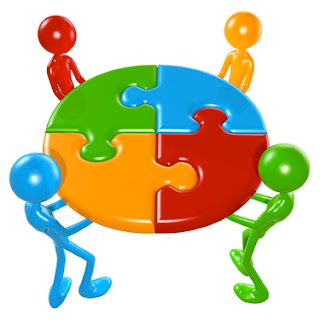 A.1.7.1
A.1.7.1A.1.7.2
A.1.7.3
A.1.7.4
A.1.7.5
- Collaboration is a recursive process where two or more people or organizations work together toward an intersection of common goals — for example, an intellectual endeavor that is creative in nature—by sharing knowledge, learning and building consensus. Collaboration does not require leadership and can sometimes bring better results through decentralization and egalitarianism. In particular, teams that work collaboratively can obtain greater resources, recognition and reward when facing competition for finite resources.
- A workflow is a depiction of a sequence of operations, declared as work of a person, work of a simple or complex mechanism, work of a group of persons, work of an organization of staff, or machines.
- A team comprises a group of people or animals linked in a common purpose. Teams are especially appropriate for conducting tasks that are high in complexity and have many interdependent subtasks.
- A Virtual Team — also known as a Geographically Dispersed Team (GDT) — is a group of individuals who work across time, space, and organizational boundaries with links strengthened by webs of communication technology. They have complementary skills and are committed to a common purpose, have interdependent performance goals, and share an approach to work for which they hold themselves mutually accountable.
- Collaboration is a recursive process where two or more people or organizations work together toward an intersection of common goals
- Cooperation, co-operation, or coöperation is the process of working or acting together, which can be accomplished by both intentional and non-intentional agents. In its simplest form it involves things working in harmony, side by side, while in its more complicated forms, it can involve something as complex as the inner workings of a human being or even the social patterns of a nation. It is the alternative to working separately in competition. Cooperation can also be accomplished by computers, which can handle shared resources simultaneously, while sharing processor time.



1 comment:
Collaboration is a recursive process where two or more people or organizations work together toward an intersection of common goals — for example, an intellectual endeavor that is creative in nature by sharing knowledge, learning and building consensus. Collaboration does not require leadership and can sometimes bring better results through decentralization and egalitarianism.In particular, teams that work collaboratively can obtain greater resources, recognition and reward when facing competition for finite resources.
Structured methods of collaboration encourage introspection of behavior and communication.
These methods specifically aim to increase the success of teams as they engage in collaborative problem solving. Forms, rubrics, charts and graphs are useful in these situations to objectively document personal traits with the goal of improving performance in current and future projects.
Since the Second World War the term "Collaboration" acquired a very negative meaning as referring to persons and groups which help a foreign occupier of their country—due to actual use by people in European countries who worked with and for the Nazi German occupiers. Linguistically, "collaboration" implies more or less equal partners who work together—which is obviously not the case when one party is an army of occupation and the other are people of the occupied country living under the power of this army.
In order to make a distinction, the more specific term "Collaborationism" is often used for this phenomenon of collaboration with an occupying army. However, there is no water-tight distinction; "Collaboration" and "Collaborator", as well as "Collaborationism" and "Collaborationist", are often used in this pejorative sense—and even more so, the equivalent terms in French and other languages spoken in countries which experienced direct Nazi occupation.
Post a Comment